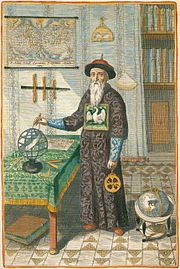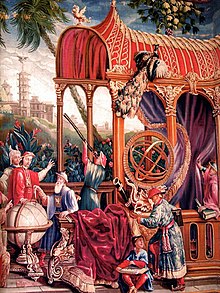| This article includes a list of general references, but it lacks sufficient corresponding inline citations. Please help to improve this article by introducing more precise citations. (March 2014) (Learn how and when to remove this message) |
| Johann Adam Schall von BellSJ | |||||||||
|---|---|---|---|---|---|---|---|---|---|
 | |||||||||
| Born | (1591-05-01)1 May 1591 Cologne or Lüftelberg, Holy Roman Empire | ||||||||
| Died | 15 August 1666(1666-08-15) (aged 75) Jingshi, Shuntian, Zhili, Qing China | ||||||||
| Resting place | Zhalan Cemetery, Beijing | ||||||||
| Alma mater | Collegium Germanicum, Gregorianum | ||||||||
| Scientific career | |||||||||
| Fields | Astronomy, religion | ||||||||
| Chinese name | |||||||||
| Traditional Chinese | 湯若望 | ||||||||
| Simplified Chinese | 汤若望 | ||||||||
| |||||||||
| Manchu name | |||||||||
| Manchu script | ᡨᠠᠩ ᡰ᠊ᠣ᠋ ᠸᠠᠩ | ||||||||
| Romanization | tang žo wang | ||||||||
Johann Adam Schall von Bell (1 May 1591 – 15 August 1666) was a German Jesuit, astronomer and instrument-maker. He spent most of his life as a missionary in China (where he is remembered as "Tang Ruowang") and became an adviser to the Shunzhi Emperor of the Qing dynasty.
Life

Schall von Bell was born to noble parents in Cologne or nearby Lüftelberg (today part of Meckenheim) in the Holy Roman Empire. After he graduated from the Jesuit Gymnasium in Cologne he moved to Rome and studied subjects such as mathematics and astronomy at the Collegium Germanicum. In 1611 he joined the Society of Jesus and continued his education at the Gregorianum.
In 1618 he left for China on a Portuguese ship with a group of missionaries under the lead of Nicolas Trigault. The next year the group reached the Portuguese trading port of Macau where Schall von Bell spent some time learning Chinese. He started missionary work inside China in 1622, but allegedly his success was limited. He participated in the defence of Macau from a Dutch invasion in the same year, and personally took a Dutch captain prisoner from that victorious battle.
Schall von Bell and Giacomo Rho were sent to Beijing in 1630 to continue the work of the deceased Johann Schreck on a reform of the Chinese calendar. With Xu Guangqi, he participated in modifying the Chinese calendar and compiling what is known as the Chongzhen calendar. Named after the Chongzhen Emperor, the last emperor of the Ming dynasty, the modified calendar provided more accurate predictions of eclipses of the sun and the moon. Upon Xu's passing, he held the requiem in his honour and oversaw the process of shipping the body back to his relatives in Shanghai. The Ming obtained the services of Father von Bell’s foundry in Beijing, which is said to have produced some five hundred cannon.
After the Ming-Qing Transition in 1644, Schall von Bell gained access to the newly installed Shunzhi Emperor and became one of his trusted counsellors. He was made a mandarin and held an important post in connection with the mathematical school: Director of the Imperial Observatory and the Tribunal of Mathematics.
His position enabled him to procure from the emperor permission for the Jesuits to build churches and to preach throughout the country. Thus Schall von Bell is indirectly credited with 500,000 Chinese that are said to have been baptised by Jesuit missionaries within fourteen years, making him a successful missionary.
The Shunzhi Emperor died in 1661 and Schall von Bell's position started to erode. In 1664 he was challenged by Yang Guangxian and the Muslim astronomers, who accused him of planning a rebellion and of having wilfully miscalculated time and place of a funeral and in that way contributed to the death of Consort Donggo. Schall von Bell and other Jesuits, Ferdinand Verbiest included, were imprisoned. Schall von Bell had a stroke in prison. At trial, Verbiest spoke in his defence, but all were condemned to death. However, after an earthquake, the Jesuits were pardoned and only five Chinese Christians working in the astronomical office were executed. The Jesuits were exiled to Macau. Schall von Bell died within one year of his release. He was buried in the Jesuits' Zhalan Cemetery in Beijing.
Yang Guangxian succeeded as the head astronomer at the court. Four years later, however, the young Kangxi Emperor replaced him with Verbiest, and von Bell's honours were fully restored.
A collection of Schall von Bell's manuscripts was deposited in the Vatican Library.
Dispute
| This section does not cite any sources. Please help improve this section by adding citations to reliable sources. Unsourced material may be challenged and removed. (September 2024) (Learn how and when to remove this message) |

In 1758, an allegation, which is disputed by most Jesuits and Catholic historians, was made public. The secretary to Monsignor Charles-Thomas Maillard De Tournon reported that during the final years of his life, Schall von Bell lived "separated from the other missionaries and removed from obedience to his superiors, in the house given him by the emperor with a woman whom he treated as his wife and who bore him two children."
No evidence was provided and the allegations are even contradicted by contemporaneous witnesses and official Chinese documents. It is stated that if true, the story would almost certainly have been reported by others who sought to discredit Schall von Bell and other Jesuits. In addition, the Jesuit structure would most likely have reported the fact to authorities at higher levels of the order.
The 1912 Catholic Encyclopedia suggests that the source of the rumour was most likely the adoption by Schall von Bell of the son of a former Chinese servant.
Encounter with Prince Sohyeon
Crown Prince Sohyeon, first son of King Injo of the Korean Joseon dynasty, was held hostage in Shenyang and later in Beijing. He was highly interested in Western sciences and visited Schall von Bell.
Schall von Bell gave him books on Western sciences as well as on the Catholic faith that drew the crown prince's interest. Prince Sohyeon suddenly died when he entered Korea in 1645, which dissipated Schall von Bell's hope to extend the Jesuit's missionary work into Korea.
Continued cultural relevance in China
In 1992, Taiwan issued a commemorative stamp for the 400th anniversary of the birth of Schall von Bell, noting "with all his accomplishments his place in Chinese history is secure".
In 2013, Chinese CCTV published a documentary on Schall von Bell, as part of its series Biographies. At the very end of the film, the commentator noted that the Chongzhen calendar edited by Schall von Bell is still in use today. China International Communication Center's major biographical series of six Westerners in premodern China also featured Schall von Bell. He is also visible in Chinese soap operas, partly because he was close to Shunzhi Emperor and palace drama is the most popular genre on Chinese TV.
See also
References
Citations
- ^ Chisholm, Hugh, ed. (1911). "Schall, Johann Adam von" . Encyclopædia Britannica. Vol. 24 (11th ed.). Cambridge University Press. p. 312.
- Goodrich, L. Carrington; Fang, Chaoying, eds. (1976). Dictionary of Ming Biography, 1368–1644. Columbia University Press. p. 1136. ISBN 0-231-03801-1.
- Blue (2001), pp. 42–43.
- Keay, John (2009). China: A History. London: HarperPress. p. 430. ISBN 9780007221783.
- Jami, Catherine (2015). "Revisiting the Calendar Case (1664-1669): Science, Religion, and Politics in Early Qing Beijing". The Korean Journal for the History of Science.
- ^ Kang, Jae-un (2006). The land of scholars: two thousand years of Korean Confucianism. translated by Lee, Suzanne. Homa & Sekey Books. pp. 338 ff. ISBN 1-931907-37-4. Retrieved 20 September 2011.
- "中華郵政全球資訊網". 中華郵政. January 13, 2016.
- "《人物》 20130724 汤若望". tv.cctv.com.
- "从西方到东方 第6集 从西方到东之汤若望". v.youku.com.
Bibliography
- Blue, Gregory (2001), "Xu Guangqi in the West: Early Jesuit Sources and the Construction of an Identity", Statecraft & Intellectual Renewal in Late Ming China: The Cross-Cultural Synthesis of Xu Guangqi (1562–1633), Sinica Leidensia, Vol. 50, Leiden: Brill, pp. 19–71, ISBN 9004120580.
- Yuan jing shuo, Explanation of the Telescope, 1626
External links
![]() Media related to Johann Adam Schall von Bell at Wikimedia Commons
Media related to Johann Adam Schall von Bell at Wikimedia Commons